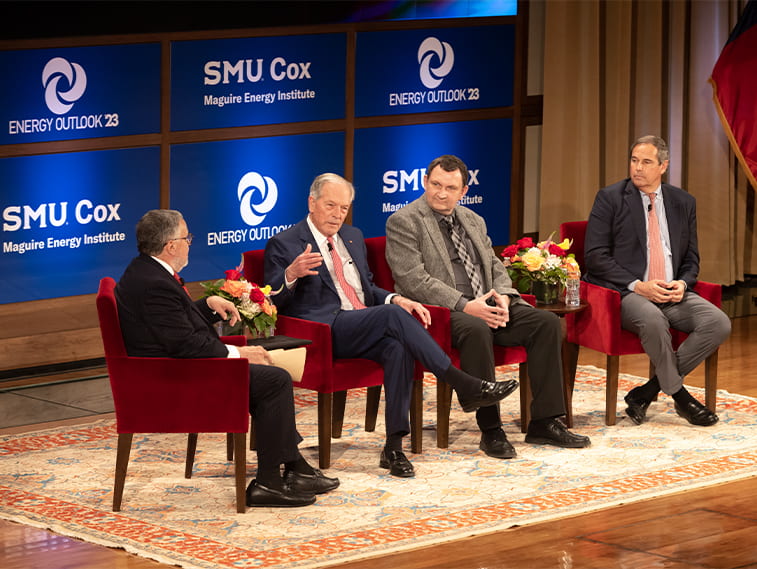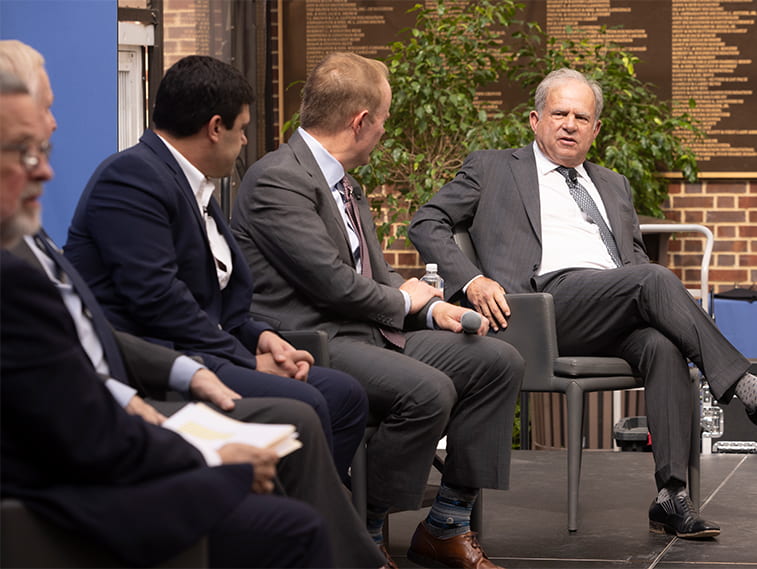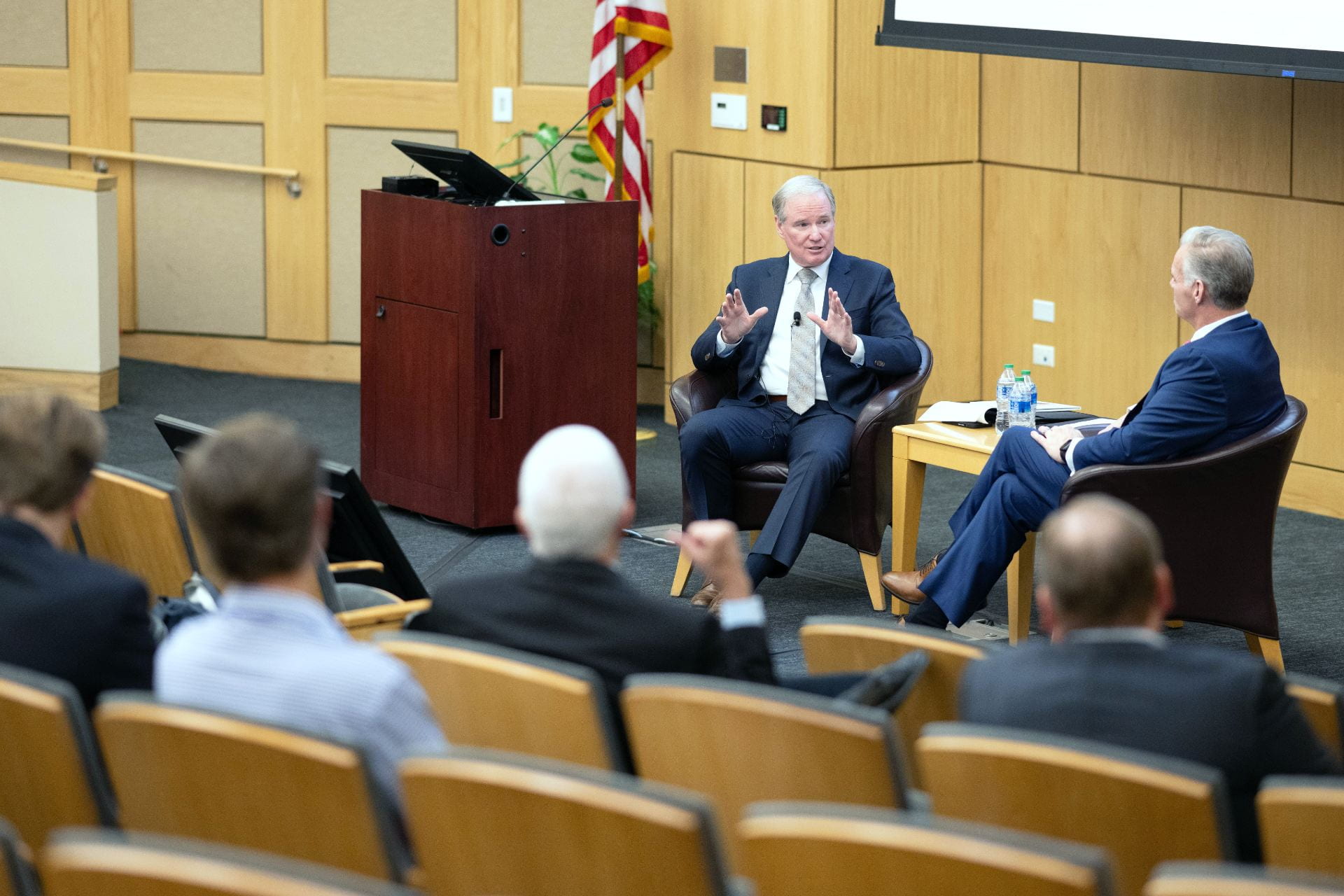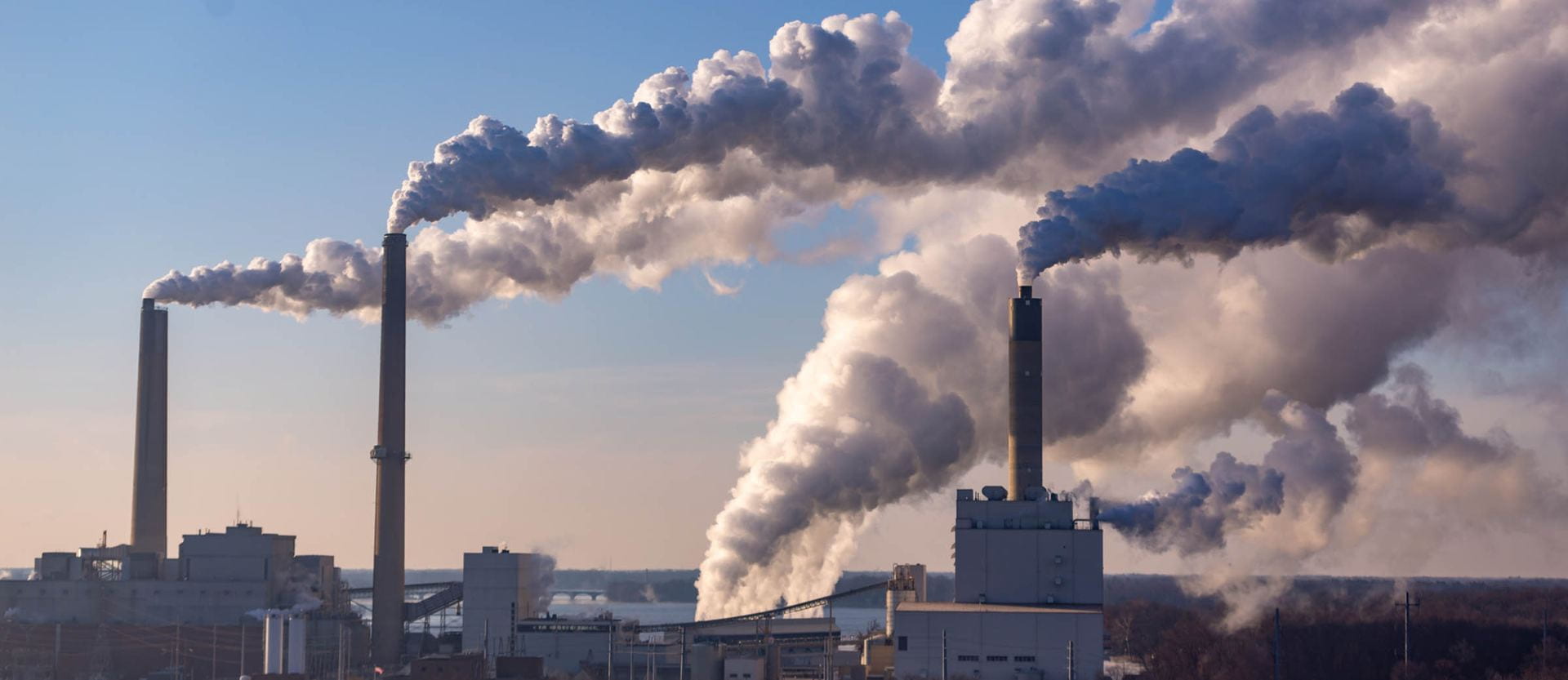We’re at a crucial time in the history of energy, and there’s never been more reason to assess the industry’s future. But with the topic eliciting strong opinions, discussions often devolve into heated debates about right and wrong.
What we need instead, says Bruce Bullock, director at the SMU Cox School of Business Maguire Energy Institute, are honest conversations about the solutions that could power us into a new era.
“We need to spend less time talking about the views of the two sides and more time talking about the solutions and how they can be implemented,” Bullock says. “Some people are going to have to put aside previous biases—I may not get my way all the time, but there are ways to move forward that can make a significant difference in reducing carbon and providing us a more sensible energy future.”
In February, the SMU Cox Maguire Energy Institute took a step in that direction by hosting a two-day event in conjunction with the George W. Bush Presidential Center that brought together about 300 stakeholders from across the world of energy—including large consumer organizations, producers and investors.
The symposium—“Energy Outlook ’23: Stewarding a Sensible Energy Future,” the first one ever organized by the Maguire Energy Institute—aimed to move past political talking points and into conversations about how energy will evolve, the way renewables and fossil fuels may work in tandem and how these issues impact the economy on a statewide, national and global scale.
“From start to finish, the entire event was excellent,” says Nick Spain, BBA ’16, a graduate of the Maguire Energy Institute’s programs and a financial analyst for Houston-based Apache Corporation, a company engaged in hydrocarbon exploration.
“I very much enjoyed being able to hear from the great lineup of speakers, connecting with others in the industry and concluding with the wonderful Pitts Energy Leadership Award dinner.”
The symposium covered a range of key issues with the aim of coming away with ideas for steering the future of energy. Here were some of the key takeaways.

The Grid and Renewables
Although the symposium drew attendees and speakers from around the U.S., it’s fitting the event took place in Texas—a state that has quickly become ground zero for discussions about grid reliability and the move toward renewable energy.
The energy crisis in 2021 left more than 5 million Texans without power and sent energy bills soaring. Concerns have mounted that another, similar weather event could create a situation with equal or even worse consequences.
The industry has gradually turned to wind and solar to fill the gaps and create a more sustainable energy future.
These renewable sources account for 19.8% of U.S. energy and 28% of energy consumed in Texas. But, as Brian Tulloh, executive director of external affairs at MISO (Midcontinent Independent System Operator), and former ERCOT CEO Brad Jones agreed during a mid-morning panel, there are practicalities to consider in the ongoing move to renewables.
Renewable energy production rises and falls intermittently depending on weather conditions, for one, creating volatile supply that generally does not align with the volatilities of demand.
“The issue with renewables is they’re harder to project,” Tulloh said. “If you have that intermittency of renewables out there, you need something that’s the reciprocal of the intermittency to balance it.”
Long-term, that could come in the form of technology such as thermal units and batteries that harness clean energy over time. But Bullock suggests that oil and gas also will be part of the mix.
“Both green energy and oil are going to have to accept that we’re going to have an all-of-the-above mixture—probably for the rest of this century,” he says.
How that mix will function, along with the transition timeline, is still very much up for debate. Jim Burke, CEO of Vistra Corp, which provides retail electricity and power generation, says two grids are emerging—the “preferred grid,” which consists of clean energy sources, and a “second” or “backup” grid, which can power on for short-term flex.
The gas system plays a key role in that flex capacity, allowing customers to maintain power even when there’s more pull on the system than usual, Burke says. “Solving that is part of the customer solution. I have not had a customer yet share with me that they’re willing to curtail and follow the renewables pattern—they want the power when they want it.”
Policy, too, has a role to play. And the panelists touched on ongoing discussions in Austin to create a regulatory environment that aligns stakeholder interests with what’s best for consumers.
“What’s being debated right now in Austin is how we should recognize and reward reliability,” says Burke. “Because we [currently] only put a value on energy. … But to actually look at power generation and [reward you for showing up or penalize you] if you don’t.”
On the other hand, Burke explains, “If you show up simply because the weather cooperated, or if you decided to turn on the plant because the price was the right amount—but you didn’t commit to do that ahead of time—you won’t get rewarded for that.”

Energy and the Economy
When it comes to energy, there are countless views both on what’s right for consumers and what’s right for the economy. The industry is tasked with settling on a path forward while aligning the two interests. It’s not always easy.
Among other topics, that dichotomy has presented itself through electric vehicles. Proponents point out that fully electric cars are greener than the gas-fueled vehicles on roads today, but panelists at the symposium pointed out the challenges ahead. Until the network of charging stations buildout, it will be difficult to reliably charge EVs on the go, panelists said, and the electricity used to charge EVs has to come from somewhere.
For now, and in the foreseeable future, that electricity mix will include fossil fuels.
“If you could magically find a vehicle with zero emissions, that sounds great,” says Lutz Kilian, senior economic policy advisor at the Federal Reserve Bank of Dallas.
“The problem is EVs are not that vehicle, and there are two reasons for that. One, battery-powered EVs use electricity, and that electricity will, for all practical purposes, be dirty and produced out of fossil fuels out of necessity. … The second reason is that EVs need to be produced. There’s a long supply chain where lots of CO2 is being produced.”
U.S. interests also have to weigh the various risk factors associated with oil and gas producers—including Russia—and producers of lithium used in battery-powered vehicles.
Although the U.S. has considerable lithium reserves it could mine, China currently processes most of the lithium that goes into EV batteries. “The biggest cost component in producing an EV is the battery—battery costs have come down tremendously in the past, and people extrapolated and said, ‘Well, they’ll keep getting cheaper and cheaper,’” Kilian says. “Given all these concerns about where the raw materials will be coming from and given recent data, it doesn’t look like battery costs will keep going down.”
This energy reliance on other countries presents a national security issue, says Ray Washburne, chairman of the board at Sunoco, a gas station operator.
Sunoco, a leader in the Hawaii market, pulls its refined gas product for its Aloha Petroleum gas stations from South Korea. On the east coast, a portion of Sunoco’s gas is imported from a refinery in Europe.
“These are the things, when you look at the chessboard of the whole thing, you have to play out,” Washburne says. “We’re just trying to distribute gasoline throughout, primarily, the east coast. We can’t get it because the last new refinery in the United States was built around 1975.”
All things considered, one of Kilian’s chief concerns right now is the electricity sector.
“The reason is that we are not thinking this through carefully enough,” he says. “If we incorporate more production from renewables, that’s going to drive down the price, at least temporarily, which will remove incentives for people to build new traditional fossil fuel power plants.”
But without technology to store renewable energy over the course of days, Kilian says the state would be leaving itself vulnerable to an event that creates extra demand, such as a snowstorm.
“There’s going to be an increase in demand coming from electrification,” he says. “But nobody seems to be sitting down and thinking it through on the supply side.”

Assessing the Energy Future
For the first time in history, according to Scott Sheffield, CEO at Pioneer Natural Resources, folks in the oil and gas industry are asking whether they’ll have a job in 20 or 30 years. In Sheffield’s eyes, that’s proof that the energy sector is trying too quickly to transition completely away from oil and gas.
In fact, all four leaders at the symposium’s Wednesday lunch panel believed the transition to clean energy is simply going to take longer than most people outside the industry would believe.
“We’ve had 200 years of oil and gas and coal, and governments are trying to cram switching to alternative energy in 25 years,” Sheffield says. “We have more natural gas in this country than probably any country in the world—probably Russia has more, but they can’t do anything with it. We should be building 30 or 40 liquified natural gas plants.”
Part of the issue, says EQT Production CEO Toby Rice, is a disconnect between the current capabilities of renewables and the public perception of what wind and solar can accomplish.
“The biggest misconception out there right now is that people think we can live in a world without coal and without traditional oil and gas,” Rice says. “15 years of investments in the richest country in the world to tell me that the solution is only solar and only wind. … We need heavyweight solutions to address these heavyweight problems.”
In the meantime, Rice and Sheffield will have their hands full managing massive companies through a period of dynamic change. Asked how many energy crises he’s had to withstand in his career to date, Sheffield said this one is “at least” the sixth. In his eyes, most of those were self-inflicted by the industry and those surrounding it.
“Either you have to have a great balance sheet, or you have to know when to hedge— and it’s hard to know when to hedge,” Sheffield says. “So, we came to the conclusion we had to have a great balance sheet—cash on the balance sheet, no debt, so you can survive the next crisis.”
Sheffield’s conversations have led him to believe the next crisis could involve China. If the country were to invade Taiwan, the world would likely back away from Chinese commodities the same way it has Russia over the last year. So, Sheffield is staying diligent, even as he predicts an upcycle in the short-term.
“Once you get that demand up, it’s going to be high prices for a period of time,” he says. “But you always have to be on the lookout for that next downturn.”

Moving Forward
In the conversations that took place over this two-day event, a common theme rose to the forefront: the need for cooperation in the opinion-saturated energy landscape.
The transition to renewables that needs to happen won’t occur overnight, but realistic short-term plans that include a mix of energy solutions are feasible and necessary to phase in long-term sustainable solutions. Experts agreed that finding a way to use all the energy tools at our disposal rather than committing to something that isn’t currently possible is the best step towards a more sensible energy future.
Shaping that path will require continued collaboration and honest conversations such as those held at the energy symposium.
“[The symposium] allowed us to reach some constituencies in the field that we had not previously touched on, such as the New Nuclear, and we broadened our view into the financial community giving everybody a better understanding of the balance between investors’ wishes,” Bullock explains.
“It showed us that as an institute, we need to have some more single-speaker, single-forum discussions on these individual solutions that are being proposed so that people can learn more about them.”
The Maguire Energy Institute, which will celebrate its 50th anniversary next year, is evaluating the cadence for future symposiums and remains committed to being a national leader in starting and seeing out those efforts.














